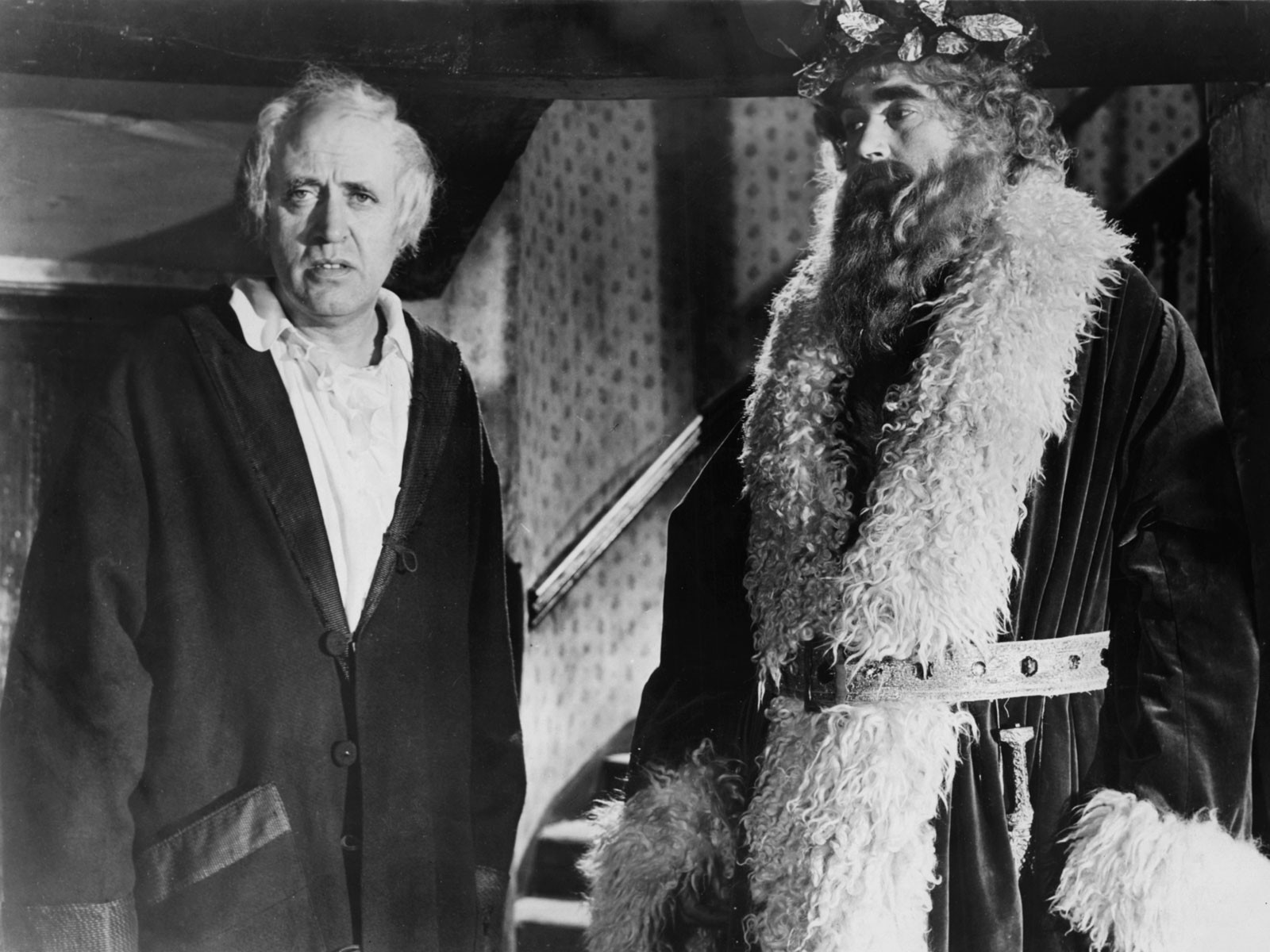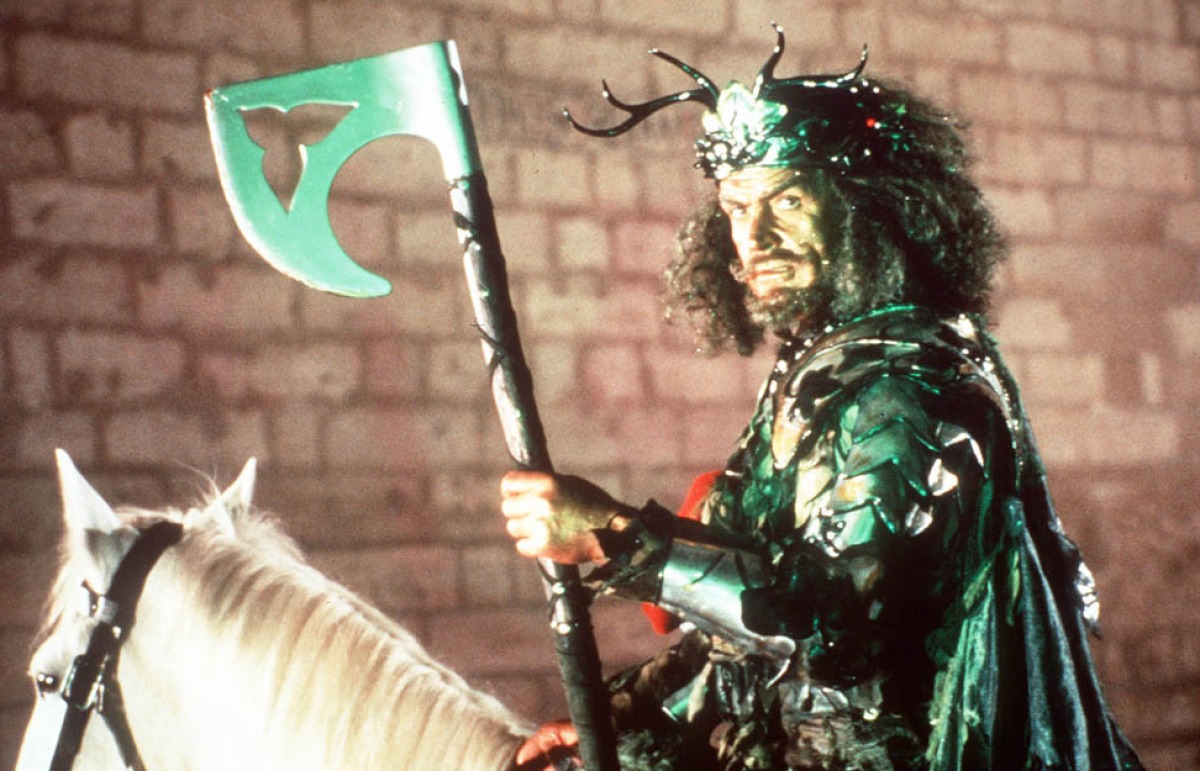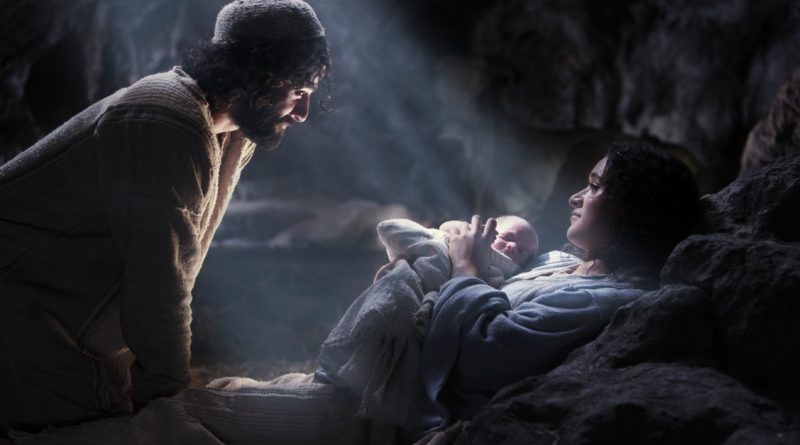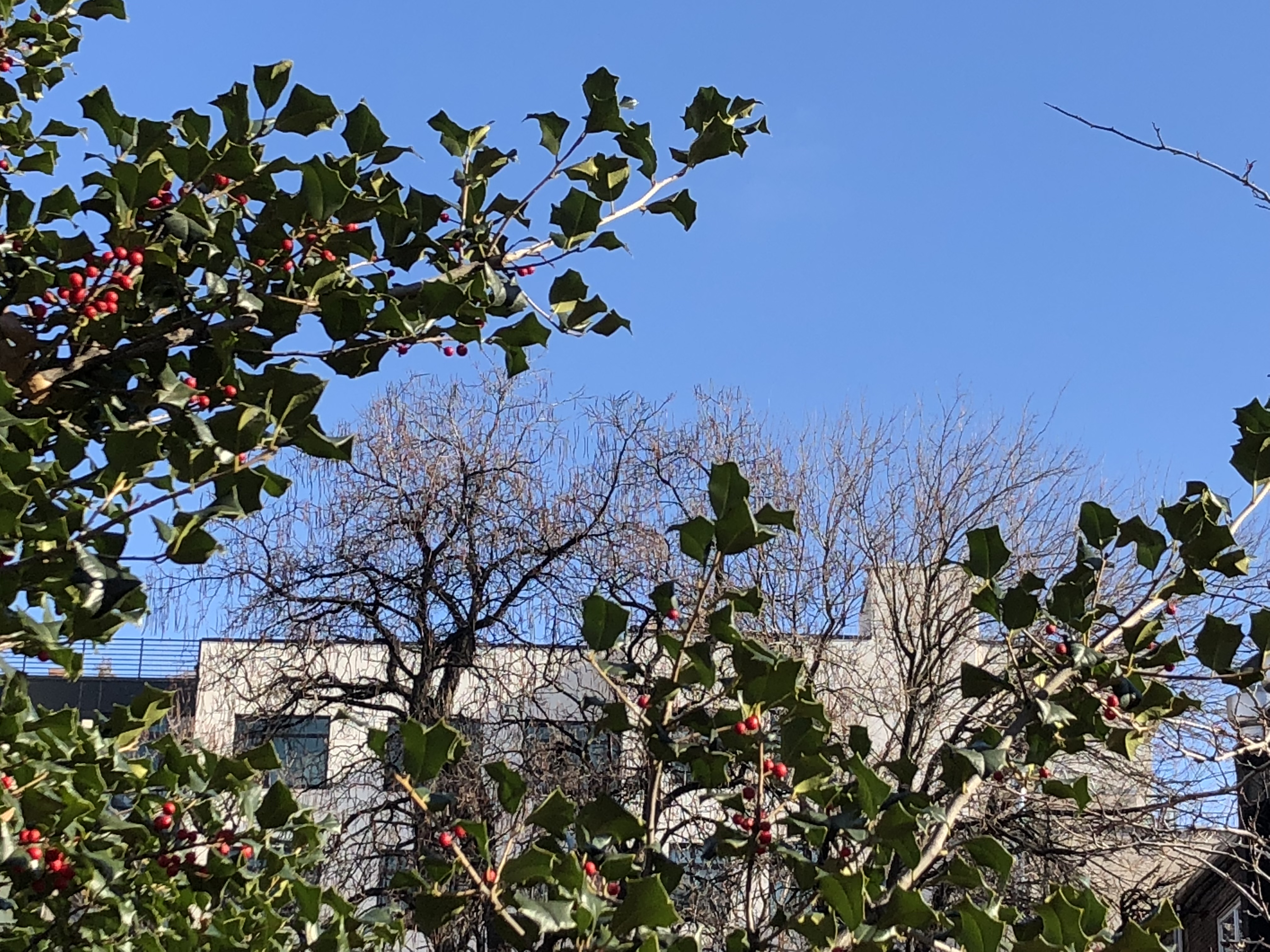
Boughs of Holly
Generally speaking, I am not a huge fan of Christmas carols. “Deck the Halls” is one of the rare exceptions, in part because it sounds so old and merry, even in the most daringly modern arrangements, but mostly because of those boughs of holly in the opening line. They are the reason, I am sure, why most of us associate the old melody—probably much older than the lyrics published by Thomas Oliphant in 1867—with the Christmas season. I like it in the voice of Nat King Cole, framed by the cinematographic blasts of the orchestra in the background. The prickly leaves and dark red berries automatically conjure images, smells, tastes, and feelings that much of humanity ancestrally associates with this time of the year—’tis the season to be jolly, to sing, drink mulled wine, and roast chestnuts in the hearth.
But why the holly? As the icy weather takes over and life seems to fade away from most trees, the holly thrives: a sign of color in the season of grays. The connection between the sturdy evergreen and the baby King whose birth Christianity celebrates near winter solstice seems only a natural one: the holly survives the winter the same way Jesus defeats death. Even the physical characteristics of the plant reference the image of Christ on the cross: the berries are red like the blood of his wounds, the leaves thorny like the crown of mockery on his head.

In A Christmas Carol, the prickly evergreen makes its entry as Scrooge walks back to his gloomy place of residence from the counting-house:
“The brightness of the shops where holly sprigs and berries crackled in the lamp heat of the windows made pale faces ruddy as they passed.”
In Dickens’ elegant sentence, the holly is presented as a healing, life-giving image of Christmas and the joy it brings. This connection is underscored later in the story, when the shapeshifting Ghost of Christmas Past materializes as announced by the terrifying ghost of Scrooge’s former partner:
“It held a branch of fresh green holly in its hand; and, in singular contradiction of that wintry emblem, had its dress trimmed with summer flowers.”
Dickens intentionally marries hollies and summer flowers to personify the force of living nature through the cosmic drama of decline and renewal. He certainly makes sure that the reader notices the apparent contradiction.
But it is later in the story, with the apparition of the Ghost of Christmas Present, that the holly seems to spill its life-giving magic more liberally, starting with the transformation of Scrooge’s room:
“The walls and ceiling were so hung with living green it looked a perfect grove; from every part of which, bright gleaming glistened. The crisp leaves of holly, mistletoe, and ivy reflected back the light, as if so many little mirrors had been scattered there…”
Here the holly is not alone—the sacred mistletoe of the druids and the ivy assist in setting the scene for the abundance and opulence that follows.

Finally, to underscore its importance, Dickens crowns the ghost’s head with holly:
“…and on his head it wore no other covering than a holly wreath, set here and there with shining icicles.”
The leaves and berries of the evergreen, we can agree, are an essential and distinctive component in these Victorian personifications of Yuletide. And the choice of the old-fashioned word from “Deck the Halls” is intentional—yule rings with Pagan overtones. It derives from the Old English geōla, which names a 12-day pagan holiday common across ancient Germanic peoples. The feast celebrated the solstice and the renewal of nature in the rebirth of the sun. And, as we will soon see, the holly was also king of that winter celebration.
The Green Knight

Sir Gawain and the Green Knight is one of the strangest stories of the Arthurian cycle. It is also a popular one, with renderings in many forms, including cinematographic ones, and even one with an all-green Sean Connery. The story tells of a lavish Christmas celebration presided by King Arthur and Queen Guinevere that gets interrupted by the unexpected arrival of an amazing green character. Just as the knights of the Round Table are getting ready to taste the first course of their Christmas meal, a very tall horseman enters the hall. Every piece of cloth on him is green, as well as his skin, his eyes, his hair and beard. Everything about him is fierce, sparkling green: green gems, green metal, green silks. Even the horse he is riding on, mane, fur, tail, and gear. But the mighty rider is barefoot, just like the Spirit of Christmas Past. The similarities don’t end here:
“And yet he had not a helm nor a hauberk either,
not a pisane, not a shaft, for shock or for blow,
but in one hand he held a holly bundle
that is greatest in greenery when groves are leafless,
and a ax in the other, ugly and monstrous,
a ruthless weapon aright for one in rhyme to describe…”
In Tolkien’s translation of the medieval English romance, the bundle of holly—in other renditions it is described as a club—stands out as a clear analog to the branch in the hand of Dickens’ Ghost of Christmas Past. They way I see it, the bundle of holly is the knight’s ID card:one issued by nature and fit for a king.
The Green Knight carries a huge ax the tool to carry out the challenge he proposes—that one of the famed knights of the Round Table take a blow at his naked neck, on the only condition that he might return the blow under the same terms. The young Gawain, Arthur’s nephew, accepts the challenge after the King himself volunteers to take the blow out of shame for the lack of volunteers among his own knights. Gawain cleanly executes the request, but after being decapitated, the Green Knight, dripping green blood, stands up, picks up his own head by the hair and gets back on his green horse. But before storming out of the castle, he reminds Gawain of his obligation to comply with his part of the deal in one year’s time.
I don’t see the need to spoil the ending for some you to make my point. We have enough clues to reveal the real identity of the character that will take a blow at Gawain’s neck when the time comes. According to John Williamson, the Green Knight is no other than the Holly King, the same archetype described by Frazer in The Golden Bough as the personification of the waning half the year. We touched on the Holly King back in October when we discussed the oak at McCarren Park—he is the second character in the title of Williamson’s study The Oak King, The Holly King, and the Unicorn.

The Holly King, whether we call him Sir Gawain or Ghost of Christmas Present, sacrifices his life at the height of his vigor during the winter solstice, transferring his power to the Oak King. The Oak King will later transfer it back to the Holly King at the height of summer, in a never-ending cosmic dance. Through the same syncretic process that transformed the image of the oak, this image of the holly as the sacrificial forest deity and safeguarder of nature became a representation of the Christian Messiah. To this day, we celebrate with the hollies that longest night of the year which carries the promise of long summer days to come.
An American King

Our young Greenpoint Holly King—the only one I could find in the neighborhood using the Street Tree Map, though I am sure there must be more—grows almost right on the site of our lost fig in Transmitter Park, right across from a tall, magnificent oak, near the playground sprinkler. On this bright, cold December day, this holly does look regal, all in green against the lifeless brown of the oak’s crown in the background. The sunlight bounces off the berries as the small tree sways in the nippy East River breeze, inviting birds to take refuge in its prickly crown.
This young king, however, is not an Illex aquifolium, the species commonly referred to as the English or European Holly, the species behind the Arthurian and Dickensian images that we discussed before. Our tree is an Illex opaca, or American Holly: a native specie, very similar to its Old World counterpart, one of about 480 species of hollies distributed worldwide.
The American Holly was an important plant for Native Americans—Its berries and leaves not only had an ornamental value, but according to one source, the leaves were used in infusions to treat coughs and other ailments. The berries were also used as buttons and even as trading items after being preserved.
The American Holly was a consoling, familiar sight to the landing Pilgrim colonizers at Plymouth in 1620. It is easy to imagine to significance of this encounter—after a long trip to an unknown land, the beloved evergreen offered a living, cherished symbol to recognize themselves outside of England. especially as the winter solstice and a brutal first the Christmas season in the New World approached.
Looking inside the dense crown of our young king, I think I would feel very safe, protected by those clusters of prickly, waxy leaves if I were a small mammal, a bird, or any other potential prey. While it is true that the holly holds a special place in our imagination, it is actually an essential plant for the survival of a number of other species during the colder months of the year. The holly berries can be slightly poisonous to humans, though the bitter taste of the fruit would prevent anyone from eating an amount that could cause serious harm. However, it supplies many creatures with sustenance when little else is available in the forest. Species of bird like the gray catbird, common flicker, cedar waxwing, mourning dove, ruffed grouse, cardinal, blue jay, mockingbird, white-throated sparrow, and wild turkey; mammals such as deers, foxes, chipmunks, squirrels, raccoons, cotton tails, and mice, and even a reptile like the box turtle all depend in this reliable food source. The holly is a strong and generous king indeed.
According to an article published in The New York Times, the Native American Holly “was once not far from extinction in the North East coast.” The excessive harvesting of fruit-bearing branches for Christmas decoration in the early 20th century seems to have been the main culprit. Extinction was fortunately averted through effective conservation policy. Many of the older strands survived and still thrive in forests along the Eastern US coast.
Advent Miracle

Advent, the time period of four weeks before Christmas on December 25, is celebrated in the Christian Church as the season of preparation for Baby Jesus’s arrival. On my way to work last Monday, in the second week of Advent, I saw a car braking inches from a man crossing the street. The light had just changed as he was in the middle of crossing. The driver honked angrily at the pedestrian, who also yelled back at him. I kept on walking, leaving the two men exchanging insults behind. I looked at the bright decorations hanging above Manhattan Avenue, but it was hard to feel that joy that Dickens conjures in some of the passages from A Christmas Carol. The violence still rang in my ears.
When I reached Greenpoint Avenue, I remember I wanted to take a few more pictures of our Illex opaca at Transmitter park, so I made a right toward the East River. Then I saw an older lady talking to the two homeless men at the corner, sitting near the warmer air coming out of the subway station. She asked the men if they liked apple pie. Then she looked inside her shopping cart, took out a pie still in its wrap, and gave it to the men. I heard them thank the lady as I moved away from that other scene. And as I got closer to the Holly King, our princely keeper of colors, kindness rang a much louder, sweeter note on my ears. And that really felt like an Advent miracle.
***
More Tree Tales from Go Green BK:
- Call of the Catalpa. José Miguel López. November 19, 2018
- An Oak Tree Grows in Greenpoint. José Miguel López. October 18, 2018
- Greenpoint Had a Fig Tree. José Miguel López. September 19, 2018
- Poet Tree. José Miguel López. April 5, 2018.


